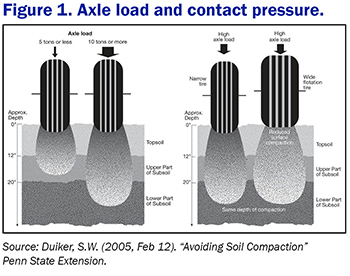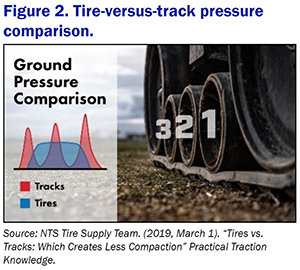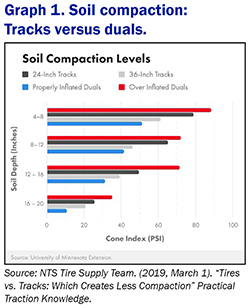
Packing density: Choose equipment to get the job done
 By Becky Arnold, Lallemand Animal Nutrition
By Becky Arnold, Lallemand Animal Nutrition
Editor’s note: This is the second article in a two-part series on silage packing density. The first article discussed the value of achieving at least 15 pounds of dry matter (DM) per cubic foot as well as managing the packing process to achieve adequate compaction.
 Dual-wheel tractors
Dual-wheel tractors
Dual-wheel tractors are often selected for compaction and stability against rollover risks. A silage pile is not as greatly affected by axle weight beyond surface compaction. The deeper the layer thickness, the more silage squishes out beneath the weight. The illustrations in Figure 1 indicate where pressure most influences particle density – under heavier weight and narrower tire width. A single-wheel row crop tractor could be a consideration for packing operations. Narrow tires increase contact pressure compared to wide tires and can be focused on the upper part of the pile or against walls.
Track tractors
Track tractors can bring more than 75,000 pounds to silage packing, but do they bring density?
Radial tires have a wave/ripple that pushes out in front of the tire as the tractor rolls forward, while a track system’s lugs are planted on the surface and push the tractor forward. This allows tracks to “float” better than tires, leading us to believe tracks offer less compaction.
 However, some track tractors can offer more compaction than their wheeled counterparts. Because of how a track tractor’s load is concentrated on the area of track beneath the idlers and bogie wheels, the track tractor’s weight is not evenly distributed across the track surface. This design allows for high-pressure points under each midroller (Figure 2).
However, some track tractors can offer more compaction than their wheeled counterparts. Because of how a track tractor’s load is concentrated on the area of track beneath the idlers and bogie wheels, the track tractor’s weight is not evenly distributed across the track surface. This design allows for high-pressure points under each midroller (Figure 2).
 The University of Minnesota found that properly inflated duals will cause less compaction than tracks (Graph 1).
The University of Minnesota found that properly inflated duals will cause less compaction than tracks (Graph 1).
Air pressure is critical to maintaining a compaction edge over the track systems. Overinflated duals carried the highest compaction across all soil depth levels. Next, 24-inch tracks brought the highest pounds per square inch.
Incorporating a track tractor to silage packing has other benefits. It will provide a smoother surface for loads to be evenly spread across. Packing thin layers across a smooth surface will be more effective than trying to spread and pack across a rough, tire-rutted surface. The smooth surface left from a final pass with a track will better bond with the plastic cover. By eliminating tire ruts, the air pockets that live between the rut and the plastic are also eliminated.
Pull-type roller packers
Pull-type roller packers add weight (2.5 to 6 tons) and provide some smoothness for similar cover and pack benefits as track systems. These attachments come in many forms, including train wheels and steel drums.
Plan for packing
Packing density is high-stakes and elusive. Remember the goal is a silage density greater than 15 pounds DM per cubic foot and getting there takes effort. Consider some of these talking points for upcoming harvest meetings and plan for the unexpected.
- Lengthen the fill ramp can give blade operators more room to spread out their blade load in a thin, even layer of 6 inches or less.
- If there is room, consider two piles to distribute truck traffic. This could also provide a more manageable feedout face.
- Start the pile in the middle and work both sides, allowing twice the truck load and packing space.
- Packing blade operators should be well-trained and know the size of loads they can efficiently spread out in uniform layers of 6 inches or less.
- The blade should not be lifted higher than the 4- to 6-inch layer being deposited. Lifting the blade to climb the slope or to offload excess silage will negatively affect packing density.
- Pack drive over piles from side to side as the progressive wedge advances. The sides should never exceed a slope of 1:3 (1-foot rise to 3-feet horizontal).
- Establish a safe, efficient driving pattern when multiple tractors are used.
- Directional pack whenever possible (back-and-forth and side-to-side). Do not drive in a circle and avoid 180-degree turns on the front apron of the pile.
| Category: |
Equipment Forage Foundations Forage storage and management Silages |

